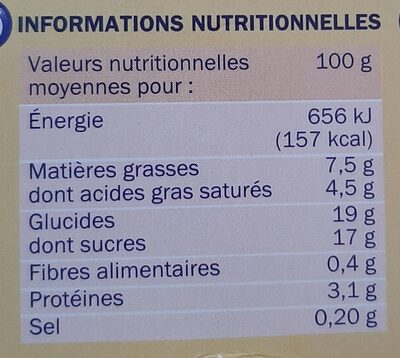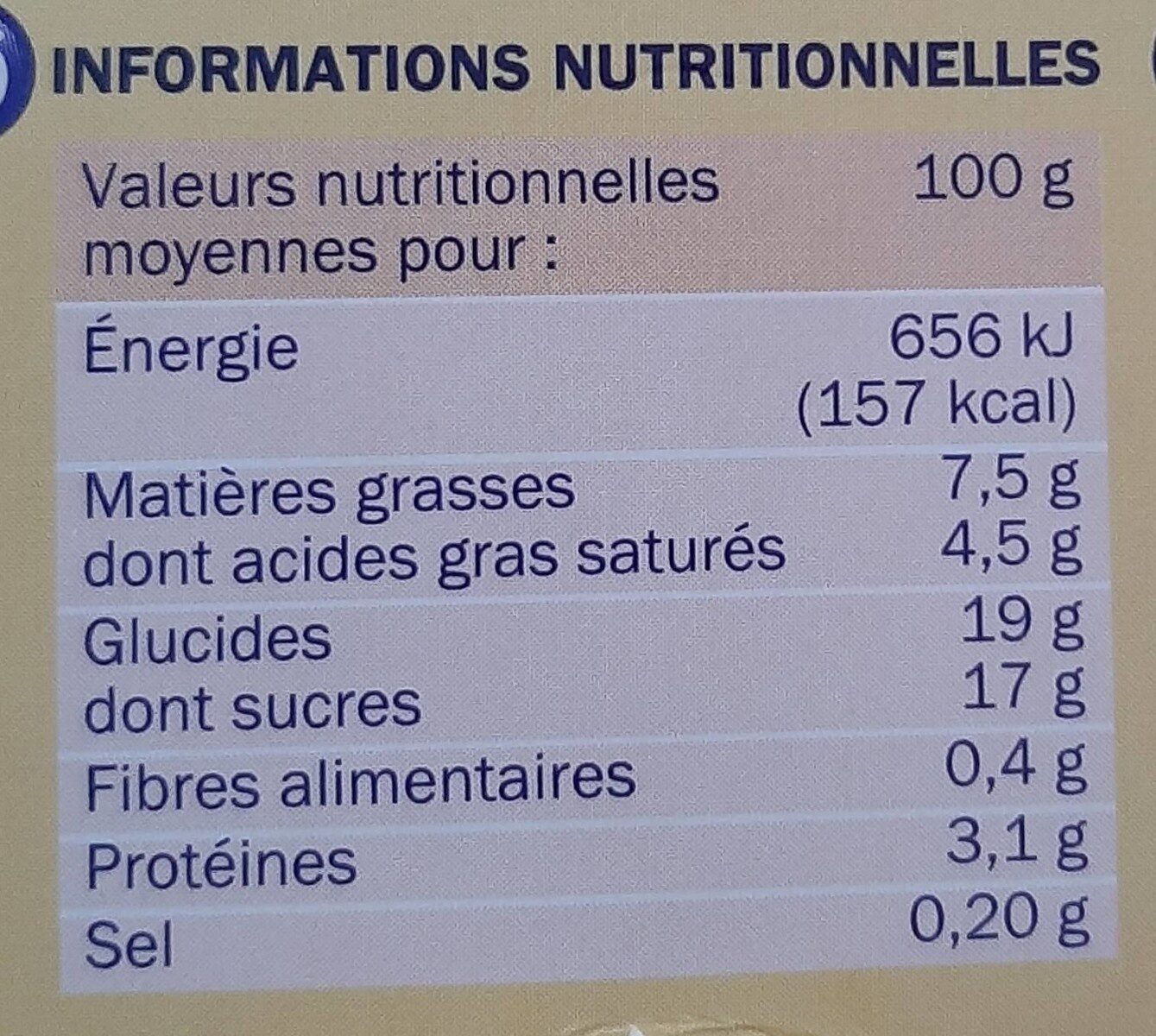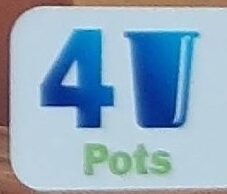Help us make food transparency the norm!
As a non-profit organization, we depend on your donations to continue informing consumers around the world about what they eat.
The food revolution starts with you!
Petit pot de crème caramel - Délisse - 4 x 100 g
Petit pot de crème caramel - Délisse - 4 x 100 g
Some of the data for this product has been provided directly by the manufacturer Scamark.
Barcode: 3564700368183 (EAN / EAN-13)
Common name: Dessert lacté au caramel
Quantity: 4 x 100 g
Packaging: Pot
Brands: Délisse, Marque Repère
Categories: Dairies, Desserts, Dairy desserts, Custard puddings, Custard puddings with caramel sauce
Labels, certifications, awards:
Nutriscore, Nutriscore Grade C, Triman
Origin of ingredients: France
Manufacturing or processing places: France
Traceability code: FR 47.185.001 CE - Montayral (Lot-et-Garonne, France)
Stores: Leclerc
Countries where sold: France
Matching with your preferences
Health
Ingredients
-
21 ingredients
: Lait entier (origine : France) 57 % ; crème (origine : France) 15 % ; caramel 10 % (sucre, eau) ; sucre ; œufs entiers extra-frais 5 % ; poudre de lait écrémé (origine : France) ; amidon modifié de manioc ; épaississants : cellulose, E466 ; arôme ; caramel 0,3 % (sirop de glucose, sucre, eau) ; gélifiant : carraghénanes ; correcteur d'acidité : E524.Allergens: MilkTraces: Gluten
Food processing
-
Ultra processed foods
Elements that indicate the product is in the 4 - Ultra processed food and drink products group:
- Additive: E14XX - Modified Starch
- Additive: E407 - Carrageenan
- Additive: E460 - Cellulose
- Additive: E466 - Sodium carboxy methyl cellulose
- Ingredient: Flavouring
- Ingredient: Gelling agent
- Ingredient: Glucose
- Ingredient: Glucose syrup
- Ingredient: Thickener
Food products are classified into 4 groups according to their degree of processing:
- Unprocessed or minimally processed foods
- Processed culinary ingredients
- Processed foods
- Ultra processed foods
The determination of the group is based on the category of the product and on the ingredients it contains.
Additives
-
E407 - Carrageenan
Carrageenan (E407), derived from red seaweed, is widely employed in the food industry as a gelling, thickening, and stabilizing agent, notably in dairy and meat products.
It can exist in various forms, each imparting distinct textural properties to food.
However, its degraded form, often referred to as poligeenan, has raised health concerns due to its potential inflammatory effects and its classification as a possible human carcinogen (Group 2B) by the International Agency for Research on Cancer (IARC).
Nevertheless, food-grade carrageenan has been deemed safe by various regulatory bodies when consumed in amounts typically found in food.
-
E460 - Cellulose
Cellulose: Cellulose is an organic compound with the formula -C6H10O5-n, a polysaccharide consisting of a linear chain of several hundred to many thousands of β-1→4- linked D-glucose units. Cellulose is an important structural component of the primary cell wall of green plants, many forms of algae and the oomycetes. Some species of bacteria secrete it to form biofilms. Cellulose is the most abundant organic polymer on Earth. The cellulose content of cotton fiber is 90%, that of wood is 40–50%, and that of dried hemp is approximately 57%.Cellulose is mainly used to produce paperboard and paper. Smaller quantities are converted into a wide variety of derivative products such as cellophane and rayon. Conversion of cellulose from energy crops into biofuels such as cellulosic ethanol is under development as a renewable fuel source. Cellulose for industrial use is mainly obtained from wood pulp and cotton.Some animals, particularly ruminants and termites, can digest cellulose with the help of symbiotic micro-organisms that live in their guts, such as Trichonympha. In human nutrition, cellulose is a non-digestible constituent of insoluble dietary fiber, acting as a hydrophilic bulking agent for feces and potentially aiding in defecation.Source: Wikipedia
-
E466 - Sodium carboxy methyl cellulose
Carboxymethyl cellulose: Carboxymethyl cellulose -CMC- or cellulose gum or tylose powder is a cellulose derivative with carboxymethyl groups --CH2-COOH- bound to some of the hydroxyl groups of the glucopyranose monomers that make up the cellulose backbone. It is often used as its sodium salt, sodium carboxymethyl cellulose.Source: Wikipedia
-
E524 - Sodium hydroxide
Sodium hydroxide: Sodium hydroxide, also known as lye and caustic soda, is an inorganic compound with the formula NaOH. It is a white solid ionic compound consisting of sodium cations Na+ and hydroxide anions OH−. Sodium hydroxide is a highly caustic base and alkali that decomposes proteins at ordinary ambient temperatures and may cause severe chemical burns. It is highly soluble in water, and readily absorbs moisture and carbon dioxide from the air. It forms a series of hydrates NaOH·nH2O. The monohydrate NaOH·H2O crystallizes from water solutions between 12.3 and 61.8 °C. The commercially available "sodium hydroxide" is often this monohydrate, and published data may refer to it instead of the anhydrous compound. As one of the simplest hydroxides, it is frequently utilized alongside neutral water and acidic hydrochloric acid to demonstrate the pH scale to chemistry students.Sodium hydroxide is used in many industries: in the manufacture of pulp and paper, textiles, drinking water, soaps and detergents, and as a drain cleaner. Worldwide production in 2004 was approximately 60 million tonnes, while demand was 51 million tonnes.Source: Wikipedia
Ingredients analysis
-
Palm oil free
No ingredients containing palm oil detected
-
Non-vegan
Non-vegan ingredients: Whole milk, Cream, fr:Œufs entiers extra-frais, Skimmed milk powder
-
Maybe vegetarian
Ingredients that may not be vegetarian: Flavouring
-
Details of the analysis of the ingredients
: Lait entier 57%, crème 15%, caramel 10% (sucre, eau), sucre, œufs entiers extra-frais 5%, poudre de lait écrémé, amidon modifié de manioc, épaississants (cellulose), e466, arôme, caramel 0.3% (sirop de glucose, sucre, eau), gélifiant (carraghénanes), correcteur d'acidité (e524)- Lait entier -> en:whole-milk - vegan: no - vegetarian: yes - ciqual_food_code: 19023 - percent_min: 57 - percent: 57 - percent_max: 57
- crème -> en:cream - vegan: no - vegetarian: yes - ciqual_food_code: 19402 - percent_min: 15 - percent: 15 - percent_max: 15
- caramel -> en:e150 - vegan: yes - vegetarian: yes - percent_min: 10 - percent: 10 - percent_max: 10
- sucre -> en:sugar - vegan: yes - vegetarian: yes - ciqual_proxy_food_code: 31016 - percent_min: 5 - percent_max: 10
- eau -> en:water - vegan: yes - vegetarian: yes - ciqual_food_code: 18066 - percent_min: 0 - percent_max: 5
- sucre -> en:sugar - vegan: yes - vegetarian: yes - ciqual_proxy_food_code: 31016 - percent_min: 5 - percent_max: 10
- œufs entiers extra-frais -> fr:oeufs-entiers-extra-frais - vegan: no - vegetarian: yes - ciqual_food_code: 22000 - percent_min: 5 - percent: 5 - percent_max: 5
- poudre de lait écrémé -> en:skimmed-milk-powder - vegan: no - vegetarian: yes - ciqual_food_code: 19054 - percent_min: 0.375 - percent_max: 4.5
- amidon modifié de manioc -> en:modified-tapioca-starch - vegan: yes - vegetarian: yes - ciqual_proxy_food_code: 9510 - percent_min: 0.3 - percent_max: 3.525
- épaississants -> en:thickener - percent_min: 0.3 - percent_max: 2.8875
- cellulose -> en:e460 - vegan: yes - vegetarian: yes - percent_min: 0.3 - percent_max: 2.8875
- e466 -> en:e466 - vegan: yes - vegetarian: yes - percent_min: 0.3 - percent_max: 2.43214285714286
- arôme -> en:flavouring - vegan: maybe - vegetarian: maybe - percent_min: 0.3 - percent_max: 2.090625
- caramel -> en:e150 - vegan: yes - vegetarian: yes - percent_min: 0.3 - percent: 0.3 - percent_max: 0.3
- sirop de glucose -> en:glucose-syrup - vegan: yes - vegetarian: yes - ciqual_proxy_food_code: 31016 - percent_min: 0 - percent_max: 0.3
- sucre -> en:sugar - vegan: yes - vegetarian: yes - ciqual_proxy_food_code: 31016 - percent_min: 0 - percent_max: 0.15
- eau -> en:water - vegan: yes - vegetarian: yes - ciqual_food_code: 18066 - percent_min: 0 - percent_max: 0.1
- gélifiant -> en:gelling-agent - percent_min: 0 - percent_max: 0.3
- carraghénanes -> en:e407 - vegan: yes - vegetarian: yes - percent_min: 0 - percent_max: 0.3
- correcteur d'acidité -> en:acidity-regulator - percent_min: 0 - percent_max: 0.3
- e524 -> en:e524 - vegan: yes - vegetarian: yes - percent_min: 0 - percent_max: 0.3
Nutrition
-
Average nutritional quality
⚠ ️Warning: the amount of fruits, vegetables and nuts is not specified on the label, it was estimated from the list of ingredients: 0This product is not considered a beverage for the calculation of the Nutri-Score.
Positive points: 1
- Proteins: 1 / 5 (value: 3.1, rounded value: 3.1)
- Fiber: 0 / 5 (value: 0.4, rounded value: 0.4)
- Fruits, vegetables, nuts, and colza/walnut/olive oils: 0 / 5 (value: 0, rounded value: 0)
Negative points: 8
- Energy: 1 / 10 (value: 656, rounded value: 656)
- Sugars: 3 / 10 (value: 17, rounded value: 17)
- Saturated fat: 4 / 10 (value: 4.5, rounded value: 4.5)
- Sodium: 0 / 10 (value: 80, rounded value: 80)
The points for proteins are counted because the negative points are less than 11.
Nutritional score: (8 - 1)
Nutri-Score:
-
Nutrient levels
-
Fat in moderate quantity (7.5%)
What you need to know- A high consumption of fat, especially saturated fats, can raise cholesterol, which increases the risk of heart diseases.
Recommendation: Limit the consumption of fat and saturated fat- Choose products with lower fat and saturated fat content.
-
Saturated fat in moderate quantity (4.5%)
What you need to know- A high consumption of fat, especially saturated fats, can raise cholesterol, which increases the risk of heart diseases.
Recommendation: Limit the consumption of fat and saturated fat- Choose products with lower fat and saturated fat content.
-
Sugars in high quantity (17%)
What you need to know- A high consumption of sugar can cause weight gain and tooth decay. It also augments the risk of type 2 diabetes and cardio-vascular diseases.
Recommendation: Limit the consumption of sugar and sugary drinks- Sugary drinks (such as sodas, fruit beverages, and fruit juices and nectars) should be limited as much as possible (no more than 1 glass a day).
- Choose products with lower sugar content and reduce the consumption of products with added sugars.
-
Salt in low quantity (0.2%)
What you need to know- A high consumption of salt (or sodium) can cause raised blood pressure, which can increase the risk of heart disease and stroke.
- Many people who have high blood pressure do not know it, as there are often no symptoms.
- Most people consume too much salt (on average 9 to 12 grams per day), around twice the recommended maximum level of intake.
Recommendation: Limit the consumption of salt and salted food- Reduce the quantity of salt used when cooking, and don't salt again at the table.
- Limit the consumption of salty snacks and choose products with lower salt content.
-
-
Nutrition facts
Nutrition facts As sold
for 100 g / 100 mlAs sold
per serving (100 g)Compared to: Custard puddings with caramel sauce Energy 656 kj
(157 kcal)656 kj
(157 kcal)-2% Fat 7.5 g 7.5 g +20% Saturated fat 4.5 g 4.5 g +29% Carbohydrates 19 g 19 g -10% Sugars 17 g 17 g -11% Fiber 0.4 g 0.4 g +167% Proteins 3.1 g 3.1 g -24% Salt 0.2 g 0.2 g +12% Fruits‚ vegetables‚ nuts and rapeseed‚ walnut and olive oils (estimate from ingredients list analysis) 0 % 0 %
Environment
-
Eco-Score A - Very low environmental impact
⚠ ️Select a country in order to include the full impact of transportation.The Eco-Score is an experimental score that summarizes the environmental impacts of food products.→ The Eco-Score was initially developped for France and it is being extended to other European countries. The Eco-Score formula is subject to change as it is regularly improved to make it more precise and better suited to each country.Life cycle analysis
-
Average impact of products of the same category: A (Score: 85/100)
Category: Custard cream with caramel sauce, refrigerated
Category: Custard cream with caramel sauce, refrigerated
- PEF environmental score: 0.24 (the lower the score, the lower the impact)
- including impact on climate change: 1.80 kg CO2 eq/kg of product
Stage Impact Agriculture
67.7 %Processing
14.0 %Packaging
6.5 %Transportation
6.9 %Distribution
3.8 %Consumption
1.0 %
Bonuses and maluses
-
Origins of ingredients with a medium impact
Bonus: +4
Environmental policy: +4
Transportation: 0
Origin of the product and/or its ingredients % of ingredients Impact France 100 %Medium
-
Packaging with a low impact
Malus: -4
Shape Material Recycling Impact 1 Sleeve Cardboard Recycle Low 4 Pot Glass Recycle Low 4 Seal Metal Recycle High ⚠ ️ The information about the packaging of this product is not sufficiently precise (exact shapes and materials of all components of the packaging).⚠ ️ For a more precise calculation of the Eco-Score, you can modify the product page and add them.
If you are the manufacturer of this product, you can send us the information with our free platform for producers.
Eco-Score for this product
-
Impact for this product: A (Score: 85/100)
Product: Petit pot de crème caramel - Délisse - 4 x 100 g
Life cycle analysis score: 85
Sum of bonuses and maluses: 0
Final score: 85/100
-
Carbon footprint
-
Equal to driving 0.9 km in a petrol car
180 g CO² per 100g of product
The carbon emission figure comes from ADEME's Agribalyse database, for the category: Custard cream with caramel sauce, refrigerated (Source: ADEME Agribalyse Database)
Stage Impact Agriculture
65.0 %Processing
10.4 %Packaging
10.3 %Transportation
11.8 %Distribution
2.1 %Consumption
0.4 %
Packaging
-
Packaging with a low impact
-
Packaging parts
1 x Sleeve (Cardboard)
4 x Pot (Glass)
4 x Seal (Metal)
-
Packaging materials
Material % Packaging weight Packaging weight per 100 g of product Paper or cardboard Glass Metal Total
-
Transportation
-
Origins of ingredients
Origins of ingredients with a medium impact
Origin of the product and/or its ingredients % of ingredients Impact France 100 %Medium
Report a problem
-
Incomplete or incorrect information?
Category, labels, ingredients, allergens, nutritional information, photos etc.
If the information does not match the information on the packaging, please complete or correct it. Open Food Facts is a collaborative database, and every contribution is useful for all.
Data sources
Product added on by date-limite-app
Last edit of product page on by moon-rabbit.
Product page also edited by autorotate-bot, cbprimula, kiliweb, openfoodfacts-contributors, org-scamark, packbot, roboto-app, scamark, tacite-mass-editor, teolemon, yuka.V1kwRkx2MG5yZlFWaHNJdXBBMlAxKzlvelp5SmNXcVZOT1k3SVE9PQ, yuka.ZVlBY0hKZzl1ZWNyaC9RNHdETEkvdDVMbHI2cmUzeTRNK0JJSVE9PQ.













